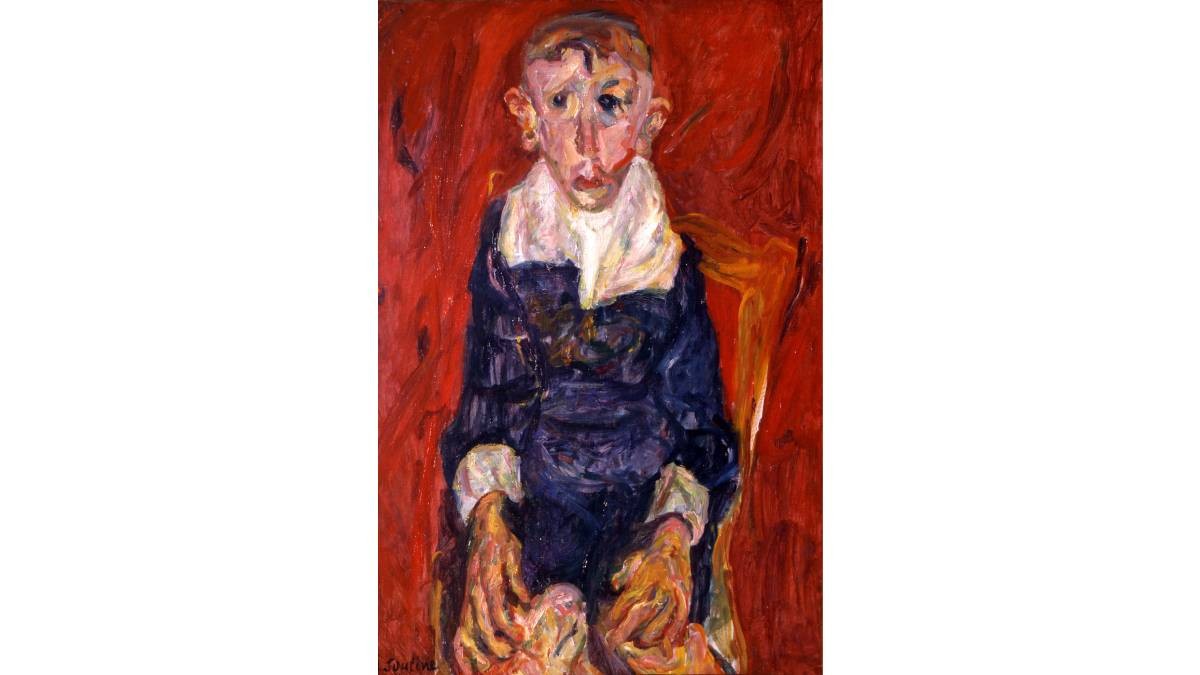Wounded Souls
When someone risks severing ties with their family and leaves the deepest reaches of the province to pursue a career as a painter in the art metropolis of Paris, their commitment to art must be unwavering. Chaïm Soutine embodied such dedication. Born in 1893 in a shtetl near Minsk as the son of a cobbler, he defied his father’s wish for him to become a rabbi and ventured to the banks of the Seine at the age of twenty.
In Paris, the solitary artist found shelter in the artists’ haven known as La Ruche. Despite grappling with poverty, he immersed himself in the avant-garde scene. Instead of following the Cubist or abstract trends of the time, he clung to figurative art, yet his work attracted attention. Amedeo Modigliani, his friend, not only enticed him into drinking but also recommended him to the art dealer Leopold Zborowski. Zborowski sent Soutine to the south of France for rejuvenation, where he produced stunning landscapes in the small Pyrenean town of Céret. Soutine’s gestural and expressive painting style caused buildings to sway as if caught in a hurricane, twisting and distorting perspective. Then there was his use of color; it flowed across the canvas like a torrent, at times directly from the tube. Turquoise, Veronese green, white, and above all, red - vermilion, crimson, purple, ruby, blood red, and incarnate.

»Dorftrottel«, verewigt im Jahr 1920; Adagp, Paris
In the “Against the Current” exhibition, currently on display at the Kunstsammlung Nordrhein-Westfalen (K20) in Düsseldorf until January 14, these captivating images greet visitors from the very beginning, leaving them speechless. Albert C. Barnes, a collector from Philadelphia, must have felt the same way when he felt compelled to purchase no fewer than 52 Soutine works from Zborowski in 1923, including the renowned “Pâtissier” and some of the Céret motifs.
Barnes’ interest marked a turning point in Soutine’s life. Overnight, he rose to prominence in the Paris art scene, donning tailored suits, residing in luxurious hotels, and striking self-assured poses for photographs. Some of these life-sized snapshots can be seen in the exhibition’s aisles. However, one should not be misled by appearances. Soutine remained a driven artist, painting with ecstatic fervor and hurling brushes at the canvas. Regarding subject matter, he steadfastly adhered to genres that were considered outdated at the time: landscapes, still lifes, and portraits. And he could only paint in front of the subject, needed its physical presence.
This principle extended to his portraits, which sometimes bordered on ordeals. Soutine consistently depicted his subjects with dented faces, crooked eyes, bulging lips, and unnaturally large ears. His favorites were altar boys and butcher boys, waiters, chambermaids, and bellboys in their uniforms.
Menschen gerieten bei Soutine nach den Schrecken des Ersten Weltkriegs zu grotesk deformierten, traumatisierten Zeitgenossen, denen die Farbe bedrohlich über den Körper kroch.
Then there were the depictions of hanged turkeys and plucked fowl, complete with bones and entrails. When Soutine attempted to paint a slaughtered ox in the style of Rembrandt, he left the carcass hanging in the studio until the decomposing flesh, showered daily with fresh blood, raised concerns with the health authorities. The eccentric artist remained a tortured soul, his inner turmoil palpable in every brushstroke.
For this reason alone, the Düsseldorf exhibition is a noteworthy event. It is remarkable that Soutine, who has had major exhibitions in cities such as Paris, London, or New York, remains comparatively lesser known in Germany. The Kunstsammlung Nordrhein-Westfalen is among the few institutions that possess works by Soutine.
With his art pulsating with sensory intensity and his visual metaphors for poverty and exclusion, for the vulnerability inherent in every living being, Soutine occupied a unique place in Parisian art circles. Curator Susanne Meyer- Büser consistently highlights his status as an immigrant, a displaced newcomer who demonstrated solidarity with the marginalized in society. She also underscores how he was received: in the postwar period, Soutine rose to become a „painter for painters“ admired by the likes of Francis Bacon and Willem de Kooning. Today, artists such as Georg Baselitz, Marlene Dumas, and Anish Kapoor draw inspiration from his legacy.
Soutine only reached the age of 50. He succumbed to a stomach ulcer in 1943, unable to reach a Paris hospital in time due to the necessity of hiding from the Nazis as a Jew.

Portrait Chaim Soutine; courtesy K20, Düsseldorf

